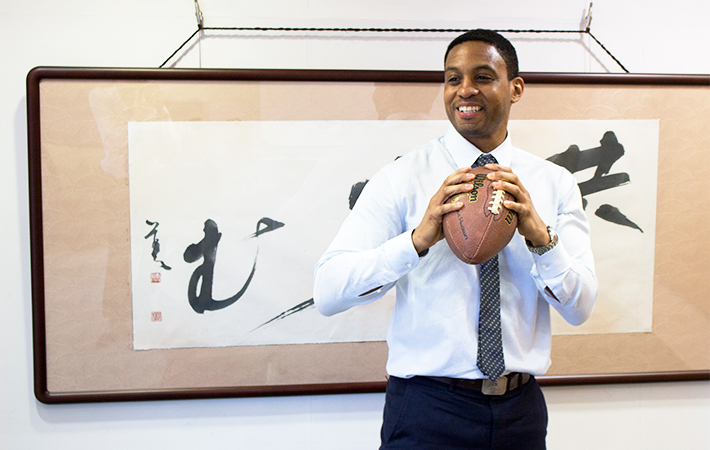第28期生メッセージ集【東京校編】
Be cosmopolitan in your outlook!

丁度、20世紀に入った頃、有名画家 藤田嗣治は日本を発ち、若いころからの夢だったフランスへ渡った。1910年にフランスの首都に降り立った、24歳の若き画家には知り合いが誰一人いなかったが、画家として世界的な名声を勝ち取る夢を持っていた。移住してから数か月後、パブロ・ピカソ、アンリ・マティス、その他有名な芸術家と友好関係を持ち、彼らは皆、藤田の作品を称賛した。20世紀を代表するダンサー・イサドラ・ダンカンとも踊ったとも言われている。藤田はすぐに自分のスタジオをモンパルナスのドゥランブル5番街に起ち上げ、その頃では珍しい、熱いお湯を自宅に引くぐらいまで収入を得ることが出来、フランスのモデル達が彼に絵を描いてもらうために列をなした。成功を収め、日本画の技法を油彩画に取り入れつつ、猫と女性をモチーフにし、独自の「乳白色の肌」とよばれた作品はヨーロッパだけでなく世界に知れ渡った。世界大恐慌の際、彼はさらに南アメリカに進出し、スタジオを開き、さらに多くの展示会を行った。アルゼンチンのブエノスアイレスにある一つの展示会では、5万人もの絵画好きが彼の作品を称賛し、1 万の人が彼のサインをもらう為に長蛇の列をなした。また藤田は当時の国際連盟と組み、作品を生み出し、世界平和を訴えかけた。その後、彼はフランス、東京、ヨーロッパと拠点を変え、行く先々に強い印象を残していった。「こんな人になりたい」と幼少期からイメージがあり、画家になるという夢を彼は見つけた。彼は日本が誇る20世紀の巨匠で間違いはないであろう。
彼の世界的知名度とは裏腹に、大半の日本人が藤田嗣治の人生や彼の作品を知らない。尊敬の念を込められ、藤田はフランス人からは「フーフー」(フランス語で「クレイジークレイジー」)と呼ばれ、日本人として初の本当の世界市民と言っても過言ではない。彼はただ海外に行ったのではなく、日本人としてフランスの文化を受け止め、フランス市民の敬意を得て、揺らぐことなく日本人としての誇りを持ち続けていた。当時、日本を発ち海外で挑戦することは、今では月に行くことと同じくらい珍しいことであった。しかしこの東京の軍事医師の息子は世界の画家の巨匠達と出会い、美術の本屋や美術館に永遠に生きる人となった。多くのNIC生は、どこの国でも自分で選んだ留学先で、藤田と同じような体験をするだろう。成功するためには、自ら進んで間違いを犯し、何度も失敗し、その経験から学ぶことが必要だ。そして人々との貴重な出会いは、1 世紀前の藤田のように、世界市民への入り口となる。他の国の人の生活に触れることで、他の国の人もあなたの生活に触れることが出来る。そして何より、あなた自身が非常に名高い可能性を秘めている。
異国の地に住み、学ぶ決断は不確定な要素が大きく、とてつもない不安が押し寄せてきます。しかしその決断は、同時に自分の想像力と創造力の試すスリルのあるテストでもあります。果敢に日本の外に出て、挑戦した人だけが本当に自分のアイデンティティを垣間見ることが出来、人との出会いによって自己形成をしていきます。藤田のように夢を追うことを忘れないでください。そして、世界市民としての観点をもつということを覚えておいてください。
Just after the turn of the 20th century, famed Japanese painter Léonard Tsugouharu Foujita left Japan and moved to France, a country where he had dreamed to live since a young age.
Arriving in the capital city in 1910, this then 24-year-old knew no one but held a dream of becoming a world-renowned artist. Within months of his arrival, he had befriended legends such as Pablo Picasso, Henri Matisse, and several other notable artists, all of whom admired his paintings. He even danced with the iconic Isodora Duncan. He soon opened a studio at no.5 rue Delambre in Montparnasse and even managed to earn enough to have hot running water, a rarity which at the time encouraged models from all corners of the French capital to flock to his studio and pose for him. He became financially successful and known throughout Europe and the rest of the world for his artwork featuring milky white women and cats, all painted with very thin brushstrokes using Japanese ink, which he always used. With the onset of the depression in Europe, he ventured even further west to South America, where he opened even more studios and held several exhibitions. At one show in particular in Buenos Aires, Argentina, more than 50,000 art lovers admired his works, and 10,000 of them stood in line for hours just to get his autograph. He also produced work with the League of Nations to promote peace around the world. He later moved back to Paris, then to Tokyo, and back to Europe making an impression everywhere he went. He had discovered his dream of becoming an artist because he had one to fulfill from a young age. He is arguably Japan's most celebrated artist of the 20th century.
Despite Léonard Tsugouharu Foujita's fame in Europe and elsewhere, most Japanese do not know much about the life and works of this man, affectionately called “Fou-Fou” (Crazy-Crazy) by the French who respected his work, but he was perhaps one of the first true cosmopolitan individuals that Japan has ever known. He didn't just go abroad as some before him had done; he successfully embraced the culture, earned the respect of the citizens there, and remained steadfast in his pride of being Japanese. He dared to venture outside of Japan during a time when traveling to Europe was as uncommon as traveling to the moon would be for most people today. This son of a Tokyo military physician would meet some of Europe's most legendary artists and mingle in circles that would forever “live” in art books and museums. He created hundreds of works that remain today as purely genius works of art. And many of students at NIC International College will have similar experiences when studying abroad, wherever your destination takes you. What you need to achieve this is the willingness to make mistakes, fail in some efforts, and grow from those experiences. What you gain from this rich encounter is the opportunity to become a cosmopolitan person like Foujita was a century ago. You will be able to touch the lives of others and, in turn, have your life touched in the same manner. You might not meet a Picasso or Matisse along your journey abroad, but perhaps you will. What’s more, you have the potential to be just as renowned.
The decision to live and study abroad is one filled with lots uncertainty and sometimes a great deal of apprehension, but with it also comes a thrilling test of your imagination and creativity.
Only those who dare to venture outside of Japan can truly see how their identities are not defined by where they were born but by whom they meet along the journey. Never forget to fulfill your dreams like this, and remember to be cosmopolitan in your outlook.

Danny K. Howard
University of Nevada, Reno MA TESL
NIC EAP Associate Director

